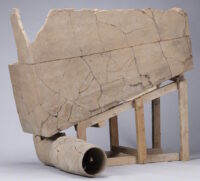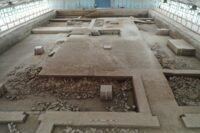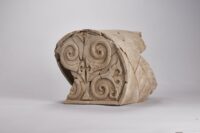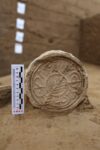 A 2,400-year-old manual flush toilet has been discovered in the remains of a palace at the Yueyang archaeological site in Xi’an, northwest China. It is the earliest known flushable toilet ever found.
A 2,400-year-old manual flush toilet has been discovered in the remains of a palace at the Yueyang archaeological site in Xi’an, northwest China. It is the earliest known flushable toilet ever found.
Discovered amid the ruins of a palace in the ancient Yueyang city, the toilet is believed to have been used by Qin Xiaogong (381-338 BC) or his father Qin Xian’gong (424-362 BC) of the Qin Kingdom during the Warring States Period (475-221 BC), or by Liu Bang, the first emperor of the Han Dynasty (206 BC-AD 220). The palace was possibly used for administrative affairs.
A “luxury object” such as a flush toilet would only be used by very high-ranking members of the society during that time, according to Liu Rui, a researcher at the Institute of Archaeology at the Chinese Academy of Social Sciences, who was part of the excavation team at Yueyang.
“It is the first and only flush toilet to be ever unearthed in China. Everybody at the site was surprised, and then we all burst into laughter,” he said.
 The first wide-scale excavation of the Yueyang City site in the 1980s revealed the first castle ruins. In 2012, archaeologists discovered two more castle complexes. Last year’s excavation explored the third of the castle complexes. Archaeologists were able to thoroughly excavate two of the palace complex’s buildings, numbers 3 and 11.
The first wide-scale excavation of the Yueyang City site in the 1980s revealed the first castle ruins. In 2012, archaeologists discovered two more castle complexes. Last year’s excavation explored the third of the castle complexes. Archaeologists were able to thoroughly excavate two of the palace complex’s buildings, numbers 3 and 11.
Buildings 3 and 11 of the third castle are rectangular and both face south. Large semi-circular roof tiles, the tops of larger cylindrical tiles known as kings’ gate tiles, were discovered at the four corners of No. 3’s foundation. The density of material allowed archaeologists to clarify where these types of tiles were used on top of palace roofs, a long-standing question.
 The toilet was discovered at the foundation of building No. 3. It originally consisted of two parts: the toilet seat that was indoors over a platform, and a curved pipe leading to a cesspit outside the house. It was flushed the same way you flush modern toilets when the water is knocked out after a storm. A bucket of water was dumped into the tank, forcing the waste out through the pipe.
The toilet was discovered at the foundation of building No. 3. It originally consisted of two parts: the toilet seat that was indoors over a platform, and a curved pipe leading to a cesspit outside the house. It was flushed the same way you flush modern toilets when the water is knocked out after a storm. A bucket of water was dumped into the tank, forcing the waste out through the pipe.
 The upper portion where the toilet seat once was has not survived, but based on tomb carvings from a couple of centuries years later in the Western Han dynasty (202 B.C. – 9 A.D.), people squatted over the toilet instead of sitting on a full seat.
The upper portion where the toilet seat once was has not survived, but based on tomb carvings from a couple of centuries years later in the Western Han dynasty (202 B.C. – 9 A.D.), people squatted over the toilet instead of sitting on a full seat.
Since its discovery in pieces last summer, researchers have been working to puzzle the fragments back together. They kept the find under wraps until they could showcase the recomposed toilet.
Experts are analyzing the soil inside, hoping to find traces of human feces and learn about the eating habits of ancient people. So far, the soil samples have only yielded traces of fertilizers used by farmers during Han Dynasty.
“The upper portion where the toilet seat once was has not survived” – Indeed, despite all odds, “flush toilets” were not uncommon, but a toilet seat? In China? 😲️
“…people squatted over the toilet instead of sitting on a full seat.”
Some friends reported me back in the ’70s when they were students staying at a student hostel, that some foreigners used the lavatory not sitting on but in a squatting position. They put their feets on the toilet pan or directly on the seat without any concern to others. And used a bottle of water instead of paper… each time there was a mess in the lavatory – but for them, it was most hygienic …